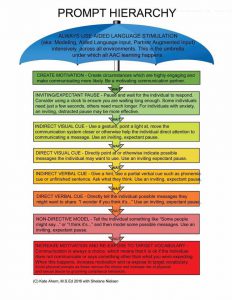 Before I became a special education teacher I hadn’t put much thought into prompting, different types of prompts, or how important it is to be aware of the prompts we give our students. Yet now, I think of a strong understanding of prompts with wait time to be one of the most important gifts we can give our students. So of course, I was thrilled when I came across this prompting hierarchy chart made specifically for students using Augmentative and Alternative Communication devices, by Kate Ahmed and Shelane Nielson.*
Before I became a special education teacher I hadn’t put much thought into prompting, different types of prompts, or how important it is to be aware of the prompts we give our students. Yet now, I think of a strong understanding of prompts with wait time to be one of the most important gifts we can give our students. So of course, I was thrilled when I came across this prompting hierarchy chart made specifically for students using Augmentative and Alternative Communication devices, by Kate Ahmed and Shelane Nielson.*
Using this prompting hierarchy communicates respect and high expectation to the student, encouraging him to do his best. We start at the top, creating motivation and opportunities for the child to express himself. Only after the child is unresponsive do we move down the chart. [Read more…]

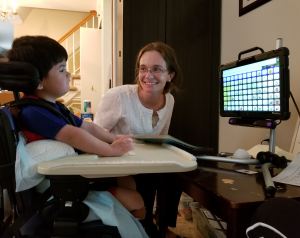 As we were reading Curious George and the Fire Fighters, Joey asked for a fire engine by saying “Fire engine” on his device and pointing to the box where I had small fire engine toys. I handed him one but he looked perturbed. “Different fire engine” he said. OK, got it, you want a different one. “Do you want big fire engine or little fire engine?” I asked in a mix of oral language and on his AAC device. He immediately looked around the room for the big fire engine, answering my question with his eye gaze.
As we were reading Curious George and the Fire Fighters, Joey asked for a fire engine by saying “Fire engine” on his device and pointing to the box where I had small fire engine toys. I handed him one but he looked perturbed. “Different fire engine” he said. OK, got it, you want a different one. “Do you want big fire engine or little fire engine?” I asked in a mix of oral language and on his AAC device. He immediately looked around the room for the big fire engine, answering my question with his eye gaze. 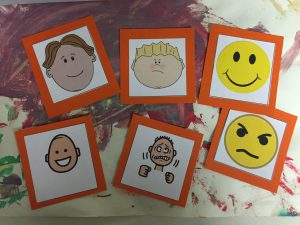 When I arrived at Joey’s house on Monday he was just waking up from a nap, and not too happy about it. We got him into his chair but he looked unimpressed as I presented him with our typical activities he normally enjoys. We started reading books, but he interrupted to tell me “mad like he.”
When I arrived at Joey’s house on Monday he was just waking up from a nap, and not too happy about it. We got him into his chair but he looked unimpressed as I presented him with our typical activities he normally enjoys. We started reading books, but he interrupted to tell me “mad like he.” 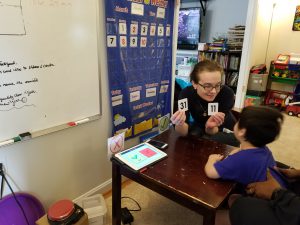 “What’s today?” I ask Joey, after we’ve counted all the numbers already posted on his wall calendar. “What comes next?” I hold up two possible choices, and every time – every time – Joey grins, stares, and then carefully moves his arm so he can clutch the card with the correct answer. It never gets old watching him proudly select the right number to put on his calendar. Although he is always correct, as his teacher I try to stay fully aware that being able to recognize what number comes next in a pattern is different than a full development of age-appropriate number sense. There are so many facets to developing mathematical thinking, and I want to be sure Joey is getting a well-rounded foundation, despite his limitations.
“What’s today?” I ask Joey, after we’ve counted all the numbers already posted on his wall calendar. “What comes next?” I hold up two possible choices, and every time – every time – Joey grins, stares, and then carefully moves his arm so he can clutch the card with the correct answer. It never gets old watching him proudly select the right number to put on his calendar. Although he is always correct, as his teacher I try to stay fully aware that being able to recognize what number comes next in a pattern is different than a full development of age-appropriate number sense. There are so many facets to developing mathematical thinking, and I want to be sure Joey is getting a well-rounded foundation, despite his limitations. 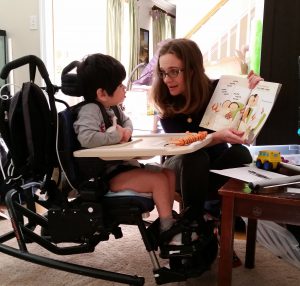 On Monday, Joey said “Dog Firetruck” on his AAC device, looked at me, and then carefully used one finger to point to the box on the floor that contained Dot the Fire Dog book and the props we use while we read aloud. Although it seemed like a small thing – two words together paired with a gesture, in turns of language development, this is a big deal. Seeing him pair language with his gestures shows that he is building an understanding of communication, and how we interact together. He can use gestures and words to communicate with me and expect that I’ll respond.
On Monday, Joey said “Dog Firetruck” on his AAC device, looked at me, and then carefully used one finger to point to the box on the floor that contained Dot the Fire Dog book and the props we use while we read aloud. Although it seemed like a small thing – two words together paired with a gesture, in turns of language development, this is a big deal. Seeing him pair language with his gestures shows that he is building an understanding of communication, and how we interact together. He can use gestures and words to communicate with me and expect that I’ll respond. 
